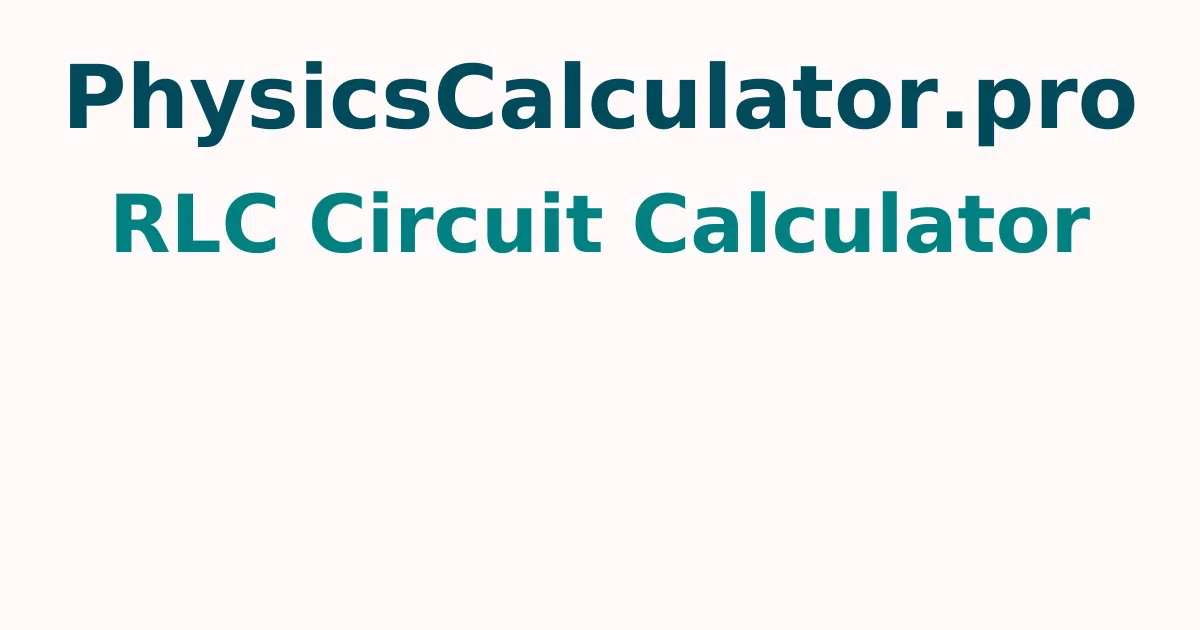RLC Circuit Calculator
Calculate the characteristic frequency and Q-factor of an RLC Circuit using the online RLC Circuit Calculator. You must enter the capacitor's capacitance, an inductor's inductance, and a resistor's resistance in the input fields, then click the calculate button to obtain exact results with a full step-by-step explanation in seconds.
What is the best way to find Frequency?
The steps to finding the characteristic frequency of an RC circuit are listed below. Follow these guidelines to get the best results for your numbers in less time.
- Step 1: Calculate resistance and capacitance.
- Step 2: Multiply the resistance and capacitance values together.
- Step 3: Multiply the result by 2π.
- Step 4: To check the characteristic frequency, get the reciprocal of the product.
RC Circuit Formula
The RC circuit is made up of a resistor and a capacitor. It is a circuit in which a resistance resistor is coupled in series with a capacitance capacitor.
There are two uses of the characteristic frequency. The RC Circuit is utilised as a capacitor charging time and as a filter. The following is the formula for calculating the RC Circuit's characteristic frequency
f = 1/(2π x R x C)
- Where, R = resistance of the resistor
- C = capacitance of the capacitor
- f = characteristic frequency
The capacitor charge time formula is t = R x C
What is RLC Circuit?
The RLC circuit is a three-element electrical circuit or device that consists of resistance, inductance, and capacitance. All of these elements are related in some way, either in series or in parallel.
RLC circuits are most commonly employed in analogue radio turning circuits, filters, and oscillators circuits to convert DC signals to AC signals.
RLC Circuit Formula
The following is the formula for calculating the resonance frequency of an RLC circuit f = 1/[2π x √(L x C)]
The natural frequency is the RLC circuit's initial characteristic number. The Q-factor is the second. The circuit's Q-factor defines how good it is. The oscillations immediately die out if the Q-factor is less than 1/2. We should try to achieve the Q-factor as high as feasible when developing the RLC circuit.
The RLC circuit's Q-factor is calculated using the formula: Q = 1/R x √(L/C)
- Where, R = Resistance
- L = inductance
- C = capacitance
- f = resonant frequency
- Q = Q-factor
How to Determine RLC Circuit's Characteristic Frequency?
Check out how to quickly compute the Q-factor and resonance frequency of any RLC Circuit. Follow these steps to find the best results.
- Step 1: Calculate the square root of the inductance and capacitance product.
- Step 2: Multiply the result by 2π.
- Step 3: Check the characteristic frequency by taking the reciprocal of the result.
- Step 4: Divide the inductance by the capacitance and multiply by the square root.
- Step 5: To get the Q-factor, multiply the result by the reciprocal of resistance.
For more concepts check out physicscalculatorpro.com to get quick answers by using this free tool.
How to Use the RLC Circuit Calculator?
The following is the procedure how to use the RLC Circuit calculator
- Step 1: Input the unknown value's capacitance, inductor's inductance, resistor's resistance and x in the appropriate input fields.
- Step 2: To acquire the result, click the "Calculate the Unknown" button.
- Step 3: Finally, the output field will show the characteristic frequency and Q-factor of an RLC Circuit.
RLC Circuit Problems with Solutions
Question 1: A series RLC circuit has a resistance of 20 ohms, an inductance of 30H, and a capacitance of 60F. What are the resonance frequencies and Q-factor of the circuit?
Solution:
Given: Resistance R = 20 Ω
Capacitance C = 60 F
Inductance L = 30 H
Resonant frequency f = 1/[2π x √(L x C)]
f = 1/[2π x √(20 x 60)]
= 1/[2π x √(1200)]
= 1/(2π x 34.64)
= 1/217.64
= 4.59 x 10^-3Hz
Q-factor Q = 1/R x √(L/C)
Q = 1/20 x √(30/60)
Q = 1/20 x √(0.5)
= 1/20 x 0.707
= 0.0353
Hence, the resonant frequency of the RLC Circuit is 4.59 x 10^-3Hz, Q factor is 0.0353.
FAQs on RLC Circuit
1. What are RLC circuits and how do they work?
RLC Circuit is a type of RLC circuit. This is an RLC circuit, which is an oscillating circuit made up of a sequence of resistors, capacitors, and inductors. The capacitor's voltage finally causes the current to cease flowing in one direction and then reverse. The outcome is a resonance or oscillation.
2. What causes RLC circuit oscillations?
The presence of a resistor in an RLC circuit causes the oscillations to fade with time, which is known as the resistor's damping effect.
3. In an RLC circuit, where do you look for XC and XL?
Inductive reactance is referred to as XL, and capacitive reactance is referred to as Xc. The formulas [ XL = 2∏fL, XC = 1/2∏fC ] are also available on that page. Both capacitance and inductance will have the same reactance at resonance.
